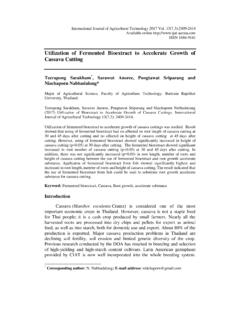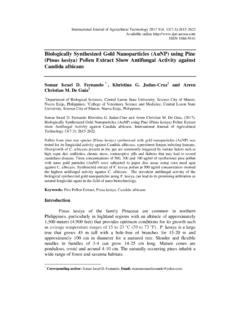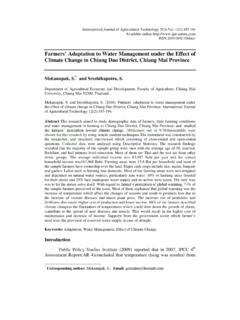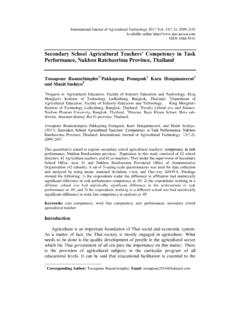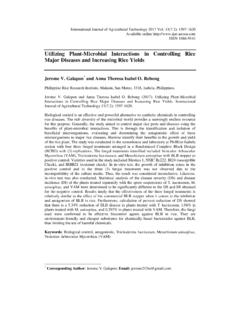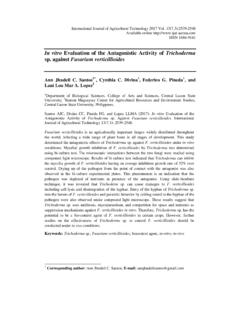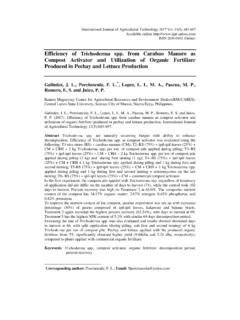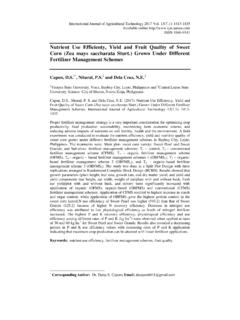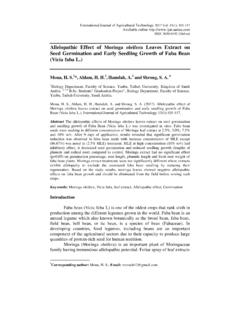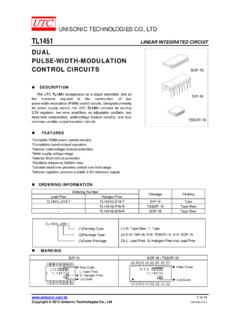Transcription of Screening of Photosynthetic Bacteria, Rhodospirllum ...
1 International Journal of Agricultural Technology 2016 Vol. 12( ):1449-1453 Available online ISSN 1686-9141 Screening of Photosynthetic bacteria , Rhodospirllum centenum for Stimulation of Rice Seed Germination R. Vareeket 1and K. Soytong1 1 Department of Plant Production Technology, Faculty of Agricultural Technology, King Mongkut s Institute of Technology Ladkrabang, Bangkok 10520, Thailand Rungrat Vareeket and Soytong, K. (2016). Screening of Photosynthetic bacteria , Rhodospirillum centenum for stimulation of rice seed germination. International Journal of Agricultural Technology 12( ):1449-1453. Purple nonsulfure bacteria (PNSB) are being used in agriculture. Some of the PNSB isolates were reported as nitrogen-fixing microorganisms in flooded rice.
2 A laboratory experiment was conducted to observe the effect of PNSB inoculation on seed germination. The experiment was conducted by using wet filter paper in petri dishes. The design of the experiment was completely randomized (CRD) with three replications. The tested isolates were the growth promoting microbes, SM41, SM61, SM72 and SM92 which were preliminary morphological identified as Rhodospirillum sp. The inoculated seeds were done with those isolates and the petri dish were incubated in the dark condition for seven days and subsequently subjected to light condition for another seven days. The seed germination and other related data were measured. The results showed that effect of tested Photosynthetic bacteria of SM41, SM61, SM72 and SM92 on seedling growth of rice showed non-significant difference but significantly differed when compared to the non-treated control.
3 The seed germination and growth of shoots were siginificantly different when compared to the non treated control. It was noted that the seedling root growth of rice var. RD41 gave a significant higher than rice var. SM92. Keywords: Photosynthetic bacteria , rice, PGP, seed germination Introduction Rice has always been the staple food of the Thai people, and it plays a crucial role as the essence of Thai life. Purple non-sulfur bacteria (PNSB) are a wide range of growth modes and able to grow under photoautotrophic, photoheterotrophic and chemoheterotrophic conditions (Imhoff and Truper, 2005). These groups of microbes are a cosmopolitan group which located in water bodies below the layer of oxygenic Photosynthetic organisms such as: algae, aquatic plants and cyanobacteria (Oda et al.)
4 , 2002). They can be found in habitats such as waste water ponds, sediments, moist soils, seawater pools and hypersaline environments (Okubo et al., 2006). The major free-living, nitrogen-fixing microbial systems include the Photosynthetic bacteria that inhabit floodwater and surface soil. These organisms absorb light through bacteriochlorophyll and carotenoid which are divided into two principal classes which include the green bacteria and 1 Coressponding Author: Rungrat Vareeket ; E-mail: 1450 the purple bacteria (Poretsky, 2003). There are many reports on plant growth promotion and yield enhancement by plant growth promoting bacteria (PGPB), as well as growth promoting mechanisms such as solubilization of insoluble phosphates (Rodriguez and Fraga, 1999) and nitrogen fixation (Kennedy et al.
5 , 1997). Purple nonsulfur bacteria (PNSB) are being searched and used in agriculture, although the precise mechanisms of growth promotion have not been elucidated (Elbadry et al., 1999). Some of the PNSB Rhodopseudomonas, Rhodospirillum, and Rhodomicrobium were reported as nitrogen-fixing microorganisms in flooded rice soils. Several studies were shown that the presence of PNSB in paddy soil may contribute to rice productivity. Harada et al. (2005) reported that inoculation of Rhodopseudomonas palustris can be increased the grain yield of rice while Rhodobacter capsulatus enhanced seedling growth, increasing shoot height of rice seedlings, regardless of rice variety (Elbadry and Elbanna, 1999).
6 In this research finding was to isolate the purple nonsulfur which isolated from wastewater and find out its efficacy of seed germination on rice var. RD41 and var. PL2. Materials and Methods Isolation of Photosynthetic bacteria The samples were randomly collected at Samutpralan Industrial Estate isolated from wastewater at Samutprakan province, Thailand. Sapmles were then isolated by using dilution plate method. The dilution was isolated by cross streak plate method in soft-agar tubes G-5 medium followed the method of Kohlmiler and Gest (1951). The tubes will be incubated under anaerobic condition with the illumination of 1,000-1,500 lux at room temperature (28-30 oC) for 7-12 days.
7 A loopful of pinkish, reddish or brownish culture was transferred by single streak onto G-5 agar and incubated under the same conditions for 7 days to get pure culture. Single colony of each isolate was transferred to G-5 agar plate to obtain pure culture. Seed germination test. Rice seeds var. RD41 and Pitsanulok 2 (PL2) were separately surface sterilized with 10 % ethanol for 5 minutes and followed by 2% sodium hypochlorite for 2 minutes, and rinsed thoroughly in sterilized distilled water. All bacterial isolates were grown in nutrient agar (NA) medium. Bacterial cells were collected twice into suspension with sterile distilled water, and the inoculation density of the bacterial suspension was International Journal of Agricultural Technology 2016 Vol.
8 12( ):1449-1453 1451 adjusted to 1x106 cells/ml by using Optical density (OD) method (Koch, 1970). Seeds were separately inoculated by overnight soaking with suspensions of bacteria (106cfu/ml). After soaking, the air-dried seeds were used for germination test. Seeds were soaked only in sterilized distilled water served as the control. Four bacterial isolates were tested as treatments in the experiment. Ten seeds of both inoculated treatments and the control were placed onto sterilized Petri dishes containing filter paper (Whatman paper No. 102). The test was incubated at room temparature, with a cycle of 10 h dark and followed by 14 h of light fluorescent. Seed germination of rice was recorded for 3 days after inoculation, and the root and shoot lengths of the germinated rice seedlings were recorded after 7 days.
9 The experiment was conducted using two factors factorial experiment in Completely Randomized Design (CRD) with four replications. Seedling germination test Seed germination was calculated with the following formula: Number of emerged seedlings Germination % = _____ x 100 Number of seeds sown Vigour index = (mean root length + mean shoot length) percentage germination (Abdul-Baki and Anderson , 1973). Results and discussion Isolation and characteristics of the isolates The samples were randomly collected at Samutpralan Industrial Estate isolated from wastewater at Samutprakan province, Thailand.
10 Isolation of photosynthesizing bacteria was done by dilution plate method on the soft-agar tubes G-5 medium to obtain pure culture. Four bacterial isolates, SM41, SM61, SM72 and SM92 were found and morphologically identified as Rhodospirillum centenum. Colonies showed reddish color, shiny and convex colony. Gram-negative, motile and cells are spiral, m in wide. As a result, Elbadry and Elbanna (1999) reported that NSB was identified as Rhodospirillum sp. which stated as as nitrogen-fixing bacteria can be isolated from paddy rice. 1452 Effect of Rhodospirillum centenum on seed germination of rice Result showed that seed germination of rice var RD41 in SM1was 45 %, and followed by SM 61, SM 72 which were 32 and 30 %, respectively and the non-tretaed control was 35 %.
